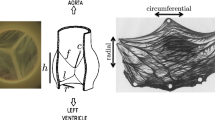Abstract
A new lumped model of flow driven by pumping without valves is presented, motivated by biomedical applications: the circulation of the human fetus before the development of the heart valves and mechanism of blood flow during the external cardiopulmonary resuscitation (CPR). The phenomenon of existence of a unidirectional net flow around a loop of tubing that consists of two different compliances is called valveless pumping. The lumped parameter model of valveless pumping in this paper is governed by the ordinary differential equations for pressure and flow, with time-dependent compliance, resistance, and inertia. This simple model can represent the essential features of valveless pumping we observed in earlier mathematical models and physical experiments of valveless pumping. We demonstrate that not only parameters of the driving function, such as frequency or amplitude, but also physical parameters, such as wall thickness and tube stiffness, are important in determining the direction and magnitude of a net flow. In this system, we report two new and interesting phenomena of valveless pumping: One is that the shifted peak frequency can be predicted by the pulsewave speed and the other is that time-dependent resistance is a crucial factor in generating valveless pumping. We also demonstrate that this lumped model can be extended to a one-dimensional flow model of valveless pumping and explain why a linear case, the case of the constant compliance, resistance, and inertia, generates almost zero net flow. This emphasizes that the nonlinearity of valveless pumping is also an important factor to generate a net flow in a closed loop model of valveless pumping.
Similar content being viewed by others
References
Auerbach, D., Moehring, W., Moser, M. 2004. An analytic approach to the Liebau problem of valveless pumping. Cardiovasc. Eng. Int. J. 4, 201.
Beattie, C., Guerci, A.D., Hall, T., Borkon, A.M., Baumgartner, W., Stuart, R.S., Peters, J., Halperin, H., Robotham, J.L., 1991. Mechanisms of blood flow during pneumatic vest cardiopulmonary resuscitation. J. Appl. Physiol. 70, 454–65.
Criley, J.M., Niemann, J.T., Rosborough, J.P., Ung, S., Suzuki, J., 1981. The heart is a conduit in CPR. Crit. Care Med. 9, 373.
Donders, F.C., 1859. Physiologie des Menchen. Hirzel, Leipzig.
Enderle, J., Blanchard, S., Bronzino, J., 2000. Introduction to Biomedical Engineering. Academic, San Diego.
Feneley, M.P., Maier, G.M., Gaynor, J.W., Gall, S.G., Kisslo, J.K., Davis, J.W., Rankin, J.S., 1987. Sequence of mitral valve motion and transmitral blood flow during manual cardiopulmonary resuscitation in dogs. Circulation 76(2), 363–75.
Guyton, A.C., Hall, J.E., 2000. Textbook of Medical Physiology, 10 edn. W.B. Saunders Company, p. 150.
Halperin, H.R., Tsitlik, J.E., Beyar, R., Chandra, N., Guerci, A.D., 1987. Intrathoracic pressure fluctuations move blood during CPR: comparison of hemodynamic data with predictions from a mathematical model. Ann. Biomed. Eng. 15, 385–03.
Hickerson, A.I., Rinderknecht, D., Gharib, M., 2005. Experimental study of a valveless impedance pump. Exp. Fluids 38(4), 534–40.
Jung, E., 1999. 2-D simulations of valveless pumping using the immersed boundary method. Ph.D. Thesis, Courant Institute, New York University.
Jung, E., Peskin, C.S., 2001. Two-dimensional simulations of valveless pumping using the immersed boundary method. SIAM J. Sci. Comput. 23, 19–5.
Kilner, P.J., 1987. Formed flow, fluid oscillation and the heart as a morphodynamic pump (abstract). Eur. Surg. Res. 19(Suppl. 1), 89–0.
Liebau, G., 1954. Uber ein Ventilloses Pumpprinzip. Naturwissenschsften 41, 327–28.
Liebau, G., 1955. Die Stromungsprinzipien des Herzens. Z. Kreislaufforsch. 44, 677–84.
Liebau, G., 1957. Die Bedeutung der Tragheitskrafte fur die Dynamik des Blutkreislaufs. Z. Kreislaufforsch. 46, 428–38.
Manopoulos, C.G., Mathioulakis, D.S., Tsangaris, S.G., 2006. One-dimensional model of valveless pumping in a closed loop and a numerical solution. Phys. Fluids 18, 017106.
Moore, K.L., 1985. Embryologie, Lehrbuch and Atlas der Entwicklungsgeschichte des Mens, 2nd. edn. Schattauer, Stuttgart, pp. 340–58
Moser, M., Huang, J.W., Schwarz, G.S., Kenner, T., Noordergraaf, A., 1998. Impedance defined flow, generalisation of William Harvey’s concept of the circulation–70 years later. Int. J. Cardiovasc. Med. Sci. 71, 205–11.
Ottesen, J.T., 2003. Valveless pumping in a fluid-filled closed elastic tube-system: one-dimensional theory with experimental validation. J. Math. Biol. 46, 309–32.
Posey, J., Geddes, L., 1973. Measurement of the modulus of elasticity of the arterial wall. Cardiovasc. Res. Cent. Bull. 11, 83–03.
Rinderknecht, D., Hickerson, A.I., Gharib, M., 2005. A valveless micro impedance pump by electromagnetic actuation. J. Micromech. Microeng. 15, 861–66.
Thomann, H., 1978. A simple pumping mechanism in a valveless tube. J. Appl. Math. Phys. 29, 169–77.
Author information
Authors and Affiliations
Corresponding author
Rights and permissions
About this article
Cite this article
Jung, E. A Mathematical Model of Valveless Pumping: A Lumped Model with Time-Dependent Compliance, Resistance, and Inertia. Bull. Math. Biol. 69, 2181–2198 (2007). https://doi.org/10.1007/s11538-007-9208-y
Received:
Accepted:
Published:
Issue Date:
DOI: https://doi.org/10.1007/s11538-007-9208-y




